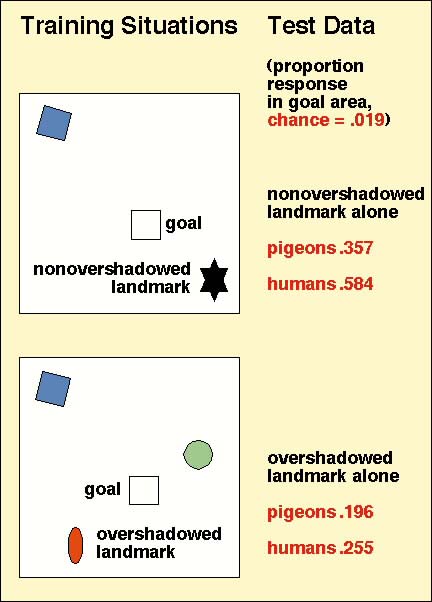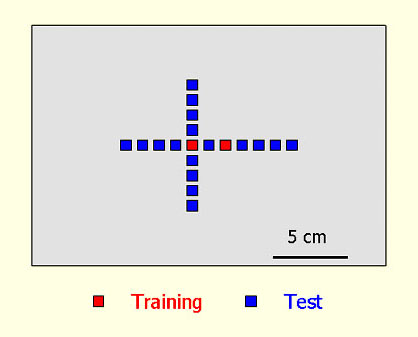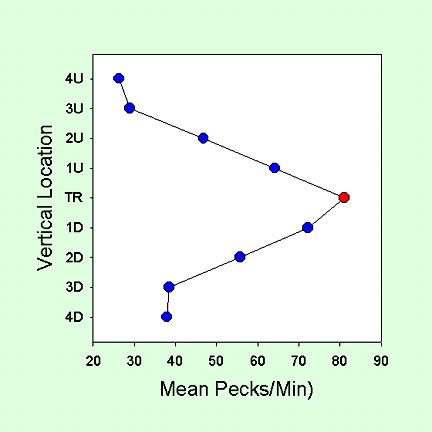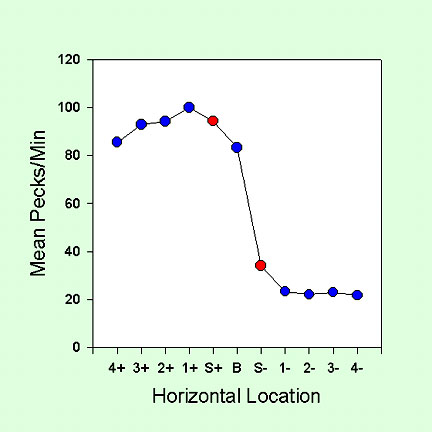Cheng
& Spetch Homepage
Next Section:
Ideas for future research
__________
|
VII. General laws of learning in the spatial domain
Some of the general laws of learning seem to apply in the spatial
domain. The next section reviews evidence for overshadowing, spatial generalization, and peak shift.
|
Overshadowing in use of landmarks

Pigeons and humans were trained with two situations, with nonovershadowed
and overshadowed landmarks, respectively (Spetch, 1995). The square indicating the goal was absent after preliminary training.
The overshadowed and nonovershadowed landmarks were the same distance
from the target (goal). The nonovershadowed landmark was nearest to the target, but the overshadowed
landmark was not the nearest to the target. The identities and locations of overshadowed and nonovershadowed landmarks
were counterbalanced across subjects. The data show the proportion of responses in the goal area.
Both pigeons and humans learned to use the nonovershadowed landmark
more effectively for locating the target.
|
|
|
Spatial generalization


Pigeons were trained to peck at a touch screen monitor with one stimulus
shown on it (Cheng, Spetch, & Johnston, 1997) as shown in the upper
figure. During training, the stimulus appeared at one of two locations shown
in red. When the stimulus was at the S+ location (the red square on the left
in this figure), pecks were rewarded. When the stimulus was at the S- location, pecks were not rewarded.
The birds were then given occasional unrewarded tests at all the locations
shown. On generalization tests, the location of the stimulus varied in the
vertical dimension, up and down from the training location on the monitor.
Results in the next figure show a generalization gradient much like that found for other
stimulus dimensions, with the training location (red
point) receiving the most pecks, and
progressively falling off to each side (blue
points).
|
|
|
Spatial Peak Shift

In the same experiment, the birds were also given tests in which the
stimulus location varied along the horizontal dimension. In this case, because they were trained with an unrewarded location
horizontally displaced from the rewarded location (S+), the peak of responding
was not at S+, but displaced from S+ in the direction away from S-. This phenomenon of peak shift is commonly found in other stimulus dimensions,
for example, in wavelength of light (Hanson, 1959).
|
|
We think that other general laws of learning in the spatial domain are
also likely (see next section). Blocking is an example. In fact,
in some ways, spatial learning is much like learning in other domains.
Undeniably, however, spatial learning also relies on special, dedicated
mechanisms such as a sun compass, an odometer,
or a geometric module. Spatial cognition is
a mix of special mechanisms and general laws. We do not believe that it
is either exclusively general all-purpose learning or exclusively a special
domain unto its own.
Next Section: Ideas for future research
|

